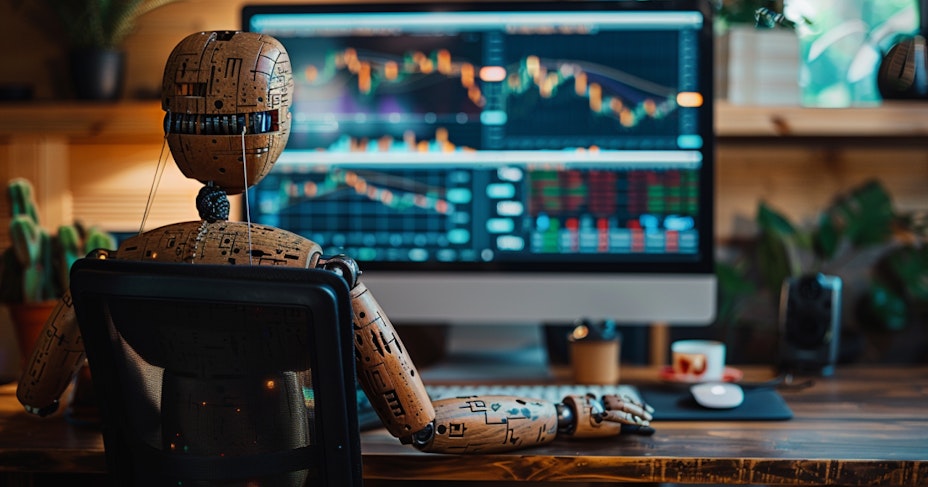Crypto corrections - How to deal with corrections during a bull market
- 15 minute read

Anyone who has been around in the world of cryptocurrency for a while knows them: corrections. Every once in a while you take another look at CoinGecko's list and suddenly the Bitcoin price starts to bounce and become substantially less valuable within a very short period of time. In its wake it drags the other coins with it and you feel a slight panic bubble up inside you. What are you going to do?

- Corrections are price decreases of 10% or more within a short period of time
- During bull markets, corrections of Bitcoin give you good opportunities for profits
- The cause of a correction can be found in excessive selling of a cryptocurrency in the face of lagging demand
- In the event of a correction, it is necessary to keep your cool and decide in advance what you will do next
- A correction during a bull market requires a very different approach than in a bear market
- Those who prepare properly for a correction can benefit greatly
Inhoudsopgave
- What is a correction?
- The difference between a correction and a bear market
- What are the causes of correction?
- Don't panic during a crypto correction or dip
- Bitcoin price correction during a bull market
- What to do during a correction in a bull market
- Market corrections outside a bull market
- Conclusion
What is a correction?

There is no general definition of a market correction, but a sort of loose description is: a 10-20% drop in prices within a short period of time (minutes to a day).
We also have the term dip, which is a drop of around 5% in a short period of time. People often say, "Buy the dip." You'll just see the coin continue to dip.
Then there is the exceptional flash crash. This means the price of a coin falls by around 50% or more within a day. All of these cozy things occur with cryptocurrency.
When the market is in its green time, the bull market, you get a little used to Bitcoin and the altcoins becoming more valuable most days. Occasionally a small minus and then green, green, green again. And then, seemingly for no apparent reason, the price of Bitcoin flies down 10% or more within an hour, which is called a correction.
Where did the term correction come from?
The term market correction comes from the stock world and represents a sudden drop within a day (often shorter) of stock prices that have been rising for some time. People there speak of a black swan, an unforeseen event with major consequences for stock prices, such as the Covid pandemic or the 2008 financial crisis. In the stock market, a correction can even take months. In cryptocurrency, we already call it a bear market. A correction in crypto usually lasts less than a day, but can have major consequences for both the market and the value of your crypto.
By the way, a correction occurs when the market leader Bitcoin drops significantly in a short period of time. If a particular coin is the only one to fall, there is usually a good reason for it, such as a doubling in supply or a 51% attack and the like.
In the now following piece, you can keep in mind that everyone should figure out their own strategy and this should not be taken as advice to buy anything.
The difference between a correction and a bear market
During a correction, prices go down sharply within a short period of time, but often recover almost as quickly, this has been seen many times in previous cycles.
In a bear market, prices keep going down as time goes on, although it may start with a correction.
Whereas bear markets are rare in the stock world, crypto traders are quickly becoming familiar with them. Since the 1970s there have only been 5 bear markets in the stock market, but in the cryptocurrency world there have been multiples of that in just 15 years or so.
Bears have a very bad name among crypto traders, perhaps that is why it has become an endangered species, while bulls thrive as before. But maybe I am seeing correlations that are not there and I am a conspiracy thinker.
What are the causes of correction?

The name correction suggests that something needs to be corrected. But what?
Generally, a correction occurs when the price has been rising for a while. For example, if Bitcoin has risen from 50K to 60K, there may come a day when it drops back to 52K within a few minutes to hours in the interim, after which it often climbs back to 60K within the foreseeable future.
Actually, the cause of a decline is very simple in a market of supply and demand. When there is more demand for Bitcoin than supply, the price rises and vice versa. So a correction is an oversupply of Bitcoin and a decline in demand, which does cause the price to fall firmly. It is also sometimes described as a dump.
Corrections in practice
If traders with a lot of Bitcoins suddenly sell large quantities, there will be downward pressure on the BTC price. These traders will either want to cash in their profits or they will be miners who put their coins on the market to pay their expenses. Professional Bitcoin whales may also make it a strategy to dump their bags together and then buy them back at a discount.
A well-known principle from the crypto market is setting a stop loss. This allows traders to protect their assets from falling too sharply in their holdings. If many Bitcoins are sold and few bought, the price of Bitcoin can fall so sharply that these stop losses all go off, causing even more Bitcoins to be sold and a violent price movement to follow. Also, leveraged long positions can be liquidated in the event of a sharp drop, which adds grist to the mill. Long positions in bull markets are quite common.
Altcoins during a correction
When this happens, you see that the altcoins often take much heavier "hits" and sometimes lose as much as 50% in value during such a Bitcoin countdown. After all, stop losses go off with these coins as well and a collapse in price follows by the same principles.
A correction does not have to cover the entire market. It can also affect just one cryptocurrency. We have seen such a correction, for example, with Solana, which fell from 220 euros to less than 20. Usually this is a different kind of correction. At Solana, there were regular problems with their network and it failed more often, followed by a correction. They were also unlucky that FTX went bankrupt and that Alameda Research had invested heavily in the Solana ICO and they were forced by their bankruptcy to put hefty amounts of Solana on the market, which led to a robust correction.
The consequences of a Bitcoin correction
The correction of a single coin has little impact on the entire market, except when it comes to Bitcoin or other highly ranked coins. Bitcoin is the market leader and largely determines what other cryptocurrencies are worth. This is due to trading in pairs, such as the Bitcoin-Ethereum pair. If the price of Bitcoin falls, Ethereum almost always falls as well, otherwise you could suddenly buy much more Bitcoin for Ethereum. Of the higher crypto currencies, pairs usually exist with all the other coins. Conversely, this is not the case. Therefore, price changes of coins like Ethereum or Bitcoin are much more important than those of coins that are much lower.
Don't panic during a crypto correction or dip
Traders who haven't been in the business that long don't have enough experience to stay calm during a correction. They see their money evaporate in a short time and decide to dump their coins at market price before they lose everything.
These moves cause the correction to widen rapidly. Those who sell at market price accept any offer, even if it is a lot lower than the current market price. If enough people do this, a downward spiral follows, which can quickly increase.
Once everyone who used the stop loss, the panicked traders and everyone else who sold their coins for one reason or another have done their thing the price usually stops falling.
During a bull market, corrections occur frequently. In many cases, substantial money is lost by traders who sell everything during a correction. You usually see that they later get back into the coins they are confident in, only to have to buy them back at a higher price. Then they have had to pay fees twice and also have fewer coins. Make sure you don't join this group.
Bitcoin price correction during a bull market
Bull markets can be over overnight. That is a fact. Market sentiment is a good indicator of this. There is even a tool invented for this. It's called the " Fear and greed index ." When it is at 0 everyone in the market is anxious and when it is at 100 everyone is greedy. At the time of writing this piece it was at 81. So people are very greedy at this time. This means that sentiment in the market is very positive and there is a good chance that the bull market will continue to roll in a direction that is favorable to people who own cryptocurrency.
Still, this will not be without controversy. There will be dips and corrections. As long as this index is very high, the market will more than likely recover.
The bottom of a correction
When the panic is over and the bottom has been found you always have those smart people who buy in at that moment because they know the sentiment and many coins are on the market for a bargain. Because there are quite a few of these traders you will soon see the price rise again. There will be more demand again and less supply, so the price may start to rise again.
After the bargain hunters fill their pockets, other traders, such as those who used their stop loss, also find out that the price is still favorable. They also decide to buy at or repurchase their coins, and so you get a train going the other way, allowing the prices of coins to fully recover to where they came from and perhaps stand a little higher in the right market conditions.
What to do during a correction in a bull market

"Be fearful when others are greedy, be greedy when others are fearful."
During a correction, traders may begin to exhibit irrational and fearful behavior. That is the time when you should be "greedy."
Some people have horns on that alert them when a cryptocurrency has experienced a particular price drop, such as through TradingView. Often these concern good purchase prices of certain coins during corrections. If the alarm goes off, they go to see if they can make their move. In the middle of the night you suddenly see the lights go on at the neighbors and then you know: a correction is underway.
If you've read this whole piece maybe a light will go on in your mind too. But if it does, then maybe I can benefit from such a quick recovery there too. Then I too will become one of those smart people who fills their pockets during the corrections in the bull market. For this you will crypto portfolio must meet certain conditions.
If you have all your money invested in cryptocurrency, it is impossible to buy additional during a correction. That's because all your money is already in crypto. Captain Obvious strikes again!
Taking advantage of a correction
So if you want to benefit from a correction you will have to put some of your assets in fiat money or stablecoins should persist. Once there is a decline pay close attention to whether the bottom is already in sight. You usually recognize this by the cessation of the rapid decline in the price of Bitcoin and the stabilization of the price or a slight rise.
As soon as you feel that the bottom is about found you quickly buy your personal favorite coins, because the price can rise again very quickly as soon as other bargain hunters start buying. If you do this at a limit price you may very well miss out, as the price keeps rising. Coins that lost the most value tend to also come back the strongest, making margins larger.
A common skill when buying correction is to set a limit price just above the market price. This way, traders do not drive up the price themselves or only marginally, while still being able to acquire coins.
Grab quick profits during correction
The purpose of such a trade is to make decent profits in as short a time as possible. Then the corrected coin is sold again, leaving a trader with cash to repeat the same trade during the next correction.
If you had all your money in coins during a correction in the bull market, then it's a matter of staying cool and sitting it out. The greed factor is high, so there is a small chance that the bull market is over. You run a small risk that the bull market is over and that this is the beginning of a bear market, but living without risk is impossible anyway, especially in crypto.
Setting an alarm that alerts you to a correction
What many traders do is work with an alarm. If you do the same, you can still profit substantially from a correction. Many traders set an alarm when the price of a coin drops between 5 and 10%. If you then sell, you suddenly have a lot of fiat money or stablecoins lying around. You can of course do exactly the same as described above, but with just about your entire stack. Of course you do not want to have just sold your coins and the correction is over and those coins are back at their original price. Then you just lost your alarm percentage.
Yet this alarm strategy comes with another small risk when greed is so high. There is no doubt that a coin can lose 5-10 percent one day. With a small dip in Bitcoin, it is often already there. Then you have to buy those coins back when you see that no correction follows. Then you lose 2x transaction costs and you run the risk of having to buy the coins back higher. Through experience you will have to find out what is the most favorable way for you to deal with this.
Limiting emotions during corrections
The one thing you should never do is panic. When this emotion takes possession of you, you can make irrational and very bad decisions that can greatly affect your overall stack. Be aware of the fact that dips, corrections and flash crashes occur. So prepare yourself for these facts and determine in advance what you're going to do then. What also helps is zooming out on charts. Then you see in a bull market that despite this correction, all coins are still well above the price of a while ago. So it's just a snapshot in time.
Also, be aware of the period in the market cycle of Bitcoin in particular. If you feel that the bull market will last a long time, then you may take more risk than if you feel that it is nearing the end. In the latter case, a crypto exit strategy might come in handy for you.
Bitcoin market cycle
To somewhat predict Bitcoin's market cycle, you can pull out Bitcoin's long-term chart and study other past cycles to get a guide to how long they last and what corrections look like. A word of caution is in order here: during the previous cycle, there was a day when Bitcoin dropped significantly and many altcoins lost around 50% in a short period of time. From May 10 to May 24, 2021, the price of Bitcoin went from 48,000 to over 28,000. Bitcoin recovered from this and tapped a new all time high later that year, but altcoins generally recovered much less and a lot of money was lost by owners of many altcoins at that time.
So when the bull market enters the later phase of its current cycle, it might be a good idea to better protect your holdings with an alarm or simply settle for your gains and cash out. You can also switch the portfolio to more Bitcoin if the altcoins have already risen a lot. In any case, you will have to be much more cautious if you feel the end of the bull market is near.
Cryptocurrency advertisements
A good indicator of this is the outside world. If you see that it's choking with advertisements for exchanges, earning themselves silly during a bull market, then the time is getting ripe. Also, if you hear really everyone talking about crypto, even people who don't have crypto, or you see people you never expected it from getting into the crypto market, then it's time to protect your assets. Remember, this is a market of supply and demand and prices can only go down if no new investors come in. It is, in effect, a zero sum game. What one person gains another must lose. Make sure you are the one and not the other!
Market corrections outside a bull market

When the Fear and Greed index is low and there is negative sentiment, it is dangerous to buy a correction. There is a lot of FUD and traders have little faith in the market's recovery. It is suddenly choking with blog stories like "when will Bitcoin recover" and similar stories with technical analysis.
If you buy up a correction in these market conditions, it is possible that several more corrections will follow in the next few days and your cryptocurrencies will become noticeably worth less and you will be virtually forced to sell them again. Of course you can also go HODLen , but then this is not the most profitable strategy. It can take years before your coins are worth the same again, some coins lose more than 90% of their value in a bear market.
Goal buying correction
The purpose of buying a correction is, of course, to quickly scrape together some coins and sell them again within a day or so so that you have more cash lying around when another correction occurs. You can also keep the coins, but then of course this is no longer possible.
Only professionals as analysts know exactly what they are doing and can buy such a correction with corresponding strategies to protect their assets in case of more corrections. Well you need a lot of patience and caution and sometimes you have to sit on your fiat money or stablecoins for years before you can get back in.
Conclusion
Bitcoin corrections are fairly common, especially in bull markets. The price of Bitcoin is really not going to rise every day, and there are traders in the market who profit from corrections. Prepare well for these things so that you know in advance exactly what you will do next.
By the way, this is a special bull market, because there are a number of Bitcoin ETFs have been added, and analysts predict this will have a strong positive impact on Bitcoin's value.
Then if there is a correction you can relax and roll out your personal strategy because you know what you are doing. If it went perfectly the way you imagined it might have hit you.


